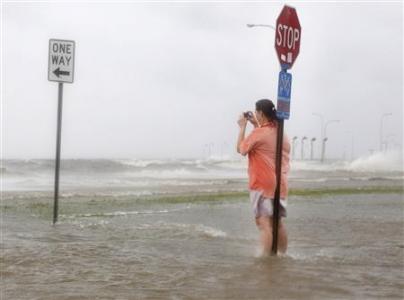(Reuters) – Hurricane Isaac lashed southern Louisiana with high winds and heavy rains on Wednesday and was set for a late-morning arrival in New Orleans, seven years to the day after Hurricane Katrina devastated the city.

Isaac is the first hurricane to make landfall in the United States this season. While not nearly as strong as Katrina — which was a Category 3 storm when it slammed the Crescent City on August 29, 2005 — Category 1 Isaac was still a powerful reminder of New Orleans’ vulnerability.
The hurricane will be the first test for multibillion-dollar flood defenses built after levees failed under Katrina’s storm surge, leaving large parts of low-lying New Orleans swamped.
The National Hurricane Center warned late on Tuesday that Isaac and its 80 mph (130kph) winds were producing dangerous storm surges, and that flooding from heavy rains was expected.
Isaac will also test the resolve of officials and the preparedness of a city and region where some 1,800 died in the 2005 hurricane, the costliest natural disaster in U.S. history.
Officials from the mayor of New Orleans to Louisiana Governor Bobby Jindal, to U.S. President Barack Obama, have scrambled to get ahead of the storm’s impact, mindful of the chaos and botched relief efforts in the wake of Katrina.
Mayor Mitch Landrieu assured residents that this time around, “your city is secure,” and said emergency services were ready for search and rescue missions.
“We’re in the heart of this fight,” Landrieu told a news conference. “We are in the hunker-down phase.”
About 1,000 U.S. National Guard troops in military vehicles took up positions in the mostly deserted streets of New Orleans, brandishing assault rifles to maintain order. Police cars patrolled darkened streets with blue lights flashing.
Obama urged residents to take heed warnings and take cover, saying that now was “not the time to tempt fate.” He issued emergency declarations for Louisiana and Mississippi earlier this week.
PUTTING NEW SYSTEMS TO THE TEST
Isaac’s arrival on the anniversary of Katrina cast a spotlight on the enduring struggle of the iconic American city, its residents and its distinctive culture.
When the 2005 storm hit, the city endured days of deadly disorder, widespread looting and other crimes. Hundreds drowned, while others waited for days to be plucked from their rooftops by Coast Guard helicopters.
Hundreds of thousands of residents, their homes flooded or made uninhabitable by mold, were moved temporarily to Texas and other states. Thousands along the Gulf Coast lived in government provided trailers for months or years afterwards.
After Katrina, the Army Corps of Engineers built a $14.5 billion defense system of walls, floodgates, levees and pumps designed to protect the city from heavy tidal surges.
On Tuesday morning, army engineers closed the floodgate at Lake Borgne, east of New Orleans, for the first time. It is largest storm-surge barrier in the world.
Most of the city’s Lower Ninth ward, scarred by memories of Katrina, was deserted on Tuesday. Residents who did not leave stocked up on water, food and fuel.
Residents of Louisiana’s low-lying Plaquemines Parish, where some flooding was already happening on Tuesday, were anxious.
Avenal Terrance, 52, who was evacuated early on Tuesday, was praying the levees would hold. “I’m living in an old trailer, not a new one, and I just hope and pray that the storm doesn’t take it,” she said.
Others decided to stick it out, some heading for local bars for a spot of courage before hunkering down at home.
“I was here for Hurricane Katrina, so I feel I’ve seen the worst. This one won’t be that bad,” said Scott Young, 56.
At 12 a.m CDT (0500 GMT), the Hurricane Center said Isaac was centered about 70 miles south of New Orleans with top sustained winds of 80 miles per hour.
Little change in strength is forecast for the next few hours, but a slow weakening is expected after that. The storm is expected to reach New Orleans late on Wednesday morning.
The center said Isaac had been “wobbling” but generally moving west-northwest” at about 7 mph. Such slow-moving cyclones can bring higher rainfall totals.
EVACUATION ORDERS, STORM SURGES
Although it only reached hurricane strength on Tuesday, Isaac killed at least 23 people and caused significant flooding and damage in Haiti and the Dominican Republic before skirting the southern tip of Florida on Sunday and heading across the warm waters of the Gulf of Mexico.
Isaac spared Tampa, Florida, where the Republican National Convention is being held, but forced party leaders to abandon most of Monday’s program, and to tone down what some might have seen as excess celebration about Mitt Romney’s presidential nomination at a time Gulf Coast residents faced danger.
The leading edge of the storm, which was about 370 miles wide, was felt along the Gulf coast. Authorities warned that Isaac could flood towns in Mississippi and Alabama, as well as Louisiana, with storm surges of up to 12 feet.
“The pecan trees are rocking and rolling…The wind is knocking dead limbs off the trees,” said Doris Sherman of Ocean Springs, Mississippi. “But we haven’t had a lot of rain yet. It is supposed to be coming. I can feel it coming.”
Rainfall accumulations, potentially totaling as much as 20 inches in some areas, could trigger widespread flooding. Over 200,000 residents of southeast Louisiana had lost power as of late Tuesday.
U.S. ENERGY OUTPUT DISRUPTED BUT FACILITIES SPARED
Energy companies along the Gulf Coast refining center braced for the storm’s impact by shuttering some plants and running others at reduced rates ahead of Isaac’s landfall.
Oil production in the U.S. Gulf of Mexico nearly ground to a halt and ports and coastal refineries curtailed operations.
Intense hurricanes such as Katrina — which took out 4.5 million barrels per day of refining capacity at one point — have flooded refineries, keeping them closed for extended periods and reducing fuel supplies.
This time, though, the U.S. Department of Energy estimated that only 12 percent of the Gulf Coast’s refining capacity had gone offline. Louisiana usually processes more than 3 million barrels per day of crude into products like gasoline.
Perceptions that the area’s oil facilities would not sustain major damage, and that production would quickly bounce back, pushed international benchmark Brent crude down slightly early Wednesday, toward $112 a barrel.
(Additional reporting by Ben Gruber in New Orleans, Emily Le Coz in Tupelo, Mississippi, Kristen Hays, Erwin Seba, Chris Baltimore in Houston, and Ellen Wullhorst in New Orleans; Writing by Anna Driver and Ros Krasny; Editing by Mary Milliken and David Brunnstrom)





